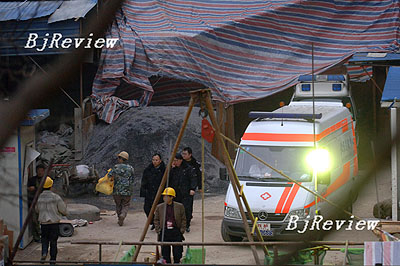
The last Wednesday in March started like every other day for people in Beijing. The mad morning commute and traffic snarls began to build as the city woke up. Construction sites around the capital reverberated with their never-ending banging. Not only above ground, but also below. And as they headed for work, few people passing overhead the construction site of the No.10 Subway Line in Haidiannanlu (Road) in the northwest of the city had any idea of the disaster playing out beneath their feet.
Behind locked doors, the construction workers had finally stopped their around-the-clock tunnel digging. It was 10:00 a.m. They had a new more urgent mission--to unearth six co-workers buried in a cave-in accident. But their boss began acting strangely. He confined the workers who took part in the rescue work to the construction site and instructed others to spray paint over the company name outside the site. He also confiscated workers' mobile phones to avoid them reporting the accident. To the workers it became clear he was covering up a tragedy. When the dust had settled, six young men had lost their lives and Beijing mourned.
The previous night workers had found a crack in the tunnel, according to a March 30 report in the Beijing Times. However, the contractor of the tunnel Zhou Yongfu ordered his staff of 60 to continue their work. On the morning of the accident, the crack widened, causing a minor collapse. It was when workers were ordered to repair this damage that the deadly cave-in happened.
The blatant cover-up attempts delayed the first-aid rescue to 5 p.m., which could have reduced the chance of survival for the trapped workers. Rescuers confirmed the next morning it was almost impossible for any trapped worker to survive. According to the Beijing Times, local police had detained 10 people over the subway cave-in by March 30, including the work supervisor and tunnel designers, but the labor contractor, Zhou Yongfu, is reported to have fled.
Dangers of subcontracting
At the end of last year, government announced its plan to build the world's biggest subway network by expanding its subway system to 273 km (169 miles) by 2010 and to 561 km by 2020. By then Beijing will replace London as the city with the world's most extensive underground rail system.
In the construction of large infrastructure projects like subways, it is common for the big contractors to subcontract the project to smaller companies, which will go on to subcontract the work to unqualified companies regardless of laws and regulations. Due to the over-subcontracting practices, the construction teams in the field, who earn very little, have neither the technical know-how nor funds to ensure work safety measures.
In the Beijing Times report, Wang Wenshan, a colleague of the deceased six workers, confirmed that excessive subcontracting existed in their company. He said their contractor had subcontracted the digging of this stretch of tunnel and hired over 150 workers to finish the job. To meet the deadline, in spite of the dangerous nature of the work, workers have to work 12-hour days.
In the wake of this catastrophe, the Ministry of Construction issued a circular on the construction safety of subway projects on April 1, which requires government at all levels to crack down on illegal subcontracting and remove unqualified construction contractors from the market.
In the same circular the ministry also demanded construction companies stick to timely reporting and rescue work in case of accidents and warned of harsh punishment for any concealment and delay in reporting.
The official Xinhua News Agency summarized the three main reasons leading up to the slow progress of rescue work. The primary reason is that rescue work was critically delayed by the seven-hour gap between the occurrence of the accident and the reporting to local police. The other two reasons are the complicated underground mass of geological factors and power grids.
| 